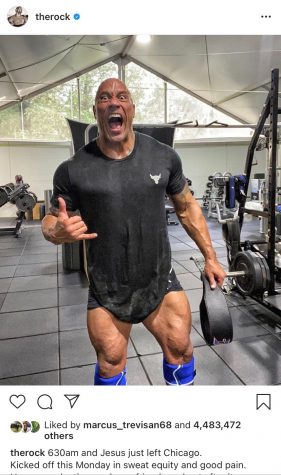The New Epidemic
Young girls see pictures like this on social media and feel that they need to lose weight to be attractive. Credit: Madison Beer
November 17, 2020
Teenagers are facing a new epidemic: mental health. Anxiety and depression levels are rising, beauty standards are ever-present, body image problems are all-consuming, and self-esteem walks a fragile line. Kids blame stress from parents and school, parents blame phones and kids, schools blame parents and phones. For children and teenagers, “major depression increased 52 percent from 2005 to 2017,” and for young adults, “it rose 63 percent,” according to the National Survey on Drug Use and Health.
Many people say that hectic schedules, increased exposure to violence, pressure to do well in school and get into a good college, and higher divorce rates have catalyzed the spike in mental health problems for adolescents. However, when comparing generations of teenagers, it is clear who the true culprit is: technology. Practically the only difference between teens in the early twenty-first century and teens in the 2010s and now, 2020s, is the prevalence of technology. Sports, school, college, jobs, extracurricular activities have always been around. There is little difference between a teenager’s schedule in 2018 than in 1998. The argument that children are exposed to more violence, whether in the news, real-life, or video games, is totally debunkable: in past generations, teenagers were the ones actually fighting in the wars and facing death firsthand, not just watching it on a TV screen. The American divorce rates have actually dropped since the 1990’s, so this is not a viable factor either.
The only other option that could be a legitimate contributor to the increased depression rates is pressure from school. Especially in the metro Atlanta suburbs, where Roswell is located, there is massive pressure to get into the University of Georgia or other colleges of the same caliber. This means that 10 or more AP classes are expected, SAT/ACT prep is encouraged, GPAs need to be in the upper three’s and preferably, the four’s. However, this College Board stress mostly stems from technology: the nation is more connected and education is standardized, so competition is increased.
Technology encompasses many different forms: social media, video games, TV shows, movies, music, computer games, etc. Of all these, social media is the most harmful. The number of ‘likes,’ views, and comments are often tied up in a child’s self-worth. ‘Likes’ aside, the bombardment of pictures of ‘perfect’ people can prove detrimental to a child’s self-esteem. A study of Roswell High School students found that a measly 11.8% say their self-esteem is high. Though this may be because of their personality and inherent tendencies, it is more likely because of their perceived lack of desirable physical attributes. Social media only perpetuates plastic beauty standards, many of them unhealthy, expensive, or impossible to attain.

Women have been rated by men for a long time. One of the first pop culture references to the 1-10 rating scale was in the movie “10,” which was released in 1979 . Rating women on the 1-10 scale has been a common theme since then, so it comes as no surprise that 96% of the surveyed Roswell High population have heard of the scale and that 57% of the surveyed group have rated people themselves. The rating system, especially after the #MeToo era, is largely seen as misogynistic and outdated. Many students reported thinking it “superficial,” “extremely shallow,” and “in no way accurate.” But what happens when students rate themselves?
Out of the students surveyed, over 33% reported that if asked to rate themselves solely on physical appearance, they would score a six. Almost 30% students gave themselves a rating of less than five. This evidence suggests a severe lack of self-confidence and self-esteem in students. Physical appearance, of course, is not all that matters, but a large part of how a person views themself is wrapped up in how attractive they feel they are to their peers, especially in high school.
After the students were asked to rate themselves, they were asked to explain why they chose the number they did. A large number cited their low self-esteem and physical features. One student said that they don’t think they’re “good enough for a higher score.” Other kids said that they felt insecure over their weight, facial features, eye color, hair, teeth, etc. Most kids felt that they were average when compared to their peers.
The low scores that students gave themselves can probably be attributed to the projection of their low self-esteem onto their rating. Most kids probably would not be as harsh when rating other classmates. The sad truth is that teenagers are struggling much more with self-esteem, body image, and mental health than past generations. The rise of technology is the only major difference between baby boomers, Gen-Xers, millennials, and current teenage generation Gen-Z. One student said it perfectly: “You see girls or even guys on [social media] and think to yourself: ‘I don’t look like that, so I must not be beautiful.’”

However, there were a few bright spots in this mostly saddening study. Some students gave positive reasons for why they rated themselves higher. These students did not give themselves a 10 because of arrogance or perceived superiority, but because they are “confident in how [they] look and think [they’re] pretty because no one else looks like [them],” or because they “learned how to love [themselves]” and believe “self-worth and self-love are very important.”
Read more about students’ mental health here.


